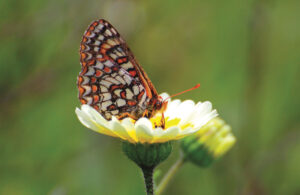Twigs! Lots and lots of twigs! The denser and more tangly, the better. Also preferred: a canopy of evergreen foliage not far off the ground to shield the inner twiggy zone from the probing eyes of an overhead hawk or nearby scrub-jay. Criss-crossing this humble jungle, narrow thoroughfares, open to the small and nimble. Adorn this understory with spider silk, add a few berries, and voilá: a perfect setting for wrentit life.
Small and relatively common, the wrentit is highly unusual among our local birds. It does not migrate or even disperse far from its birthplace; it remains in one territory for life and is likely North America’s most sedentary bird. How the wrentit came to be here is a biogeographic mystery: It has no close relatives, anywhere, and is the sole representative of its avian family (the babblers) in the New World. Its entire range is a narrow swath of North America between the Columbia River and northern Baja California, from the coast inland to the Sierra/Cascade foothills.
The wrentit inhabits thick chaparral or coastal scrub, as well as some forested areas with dense understory, and thrives in the presence of poison oak. It hops and flits about on short, rounded wings, often cocking its long tail upward and softly calling to its mate-for-life. Wrentits always occur in twos, and you can listen for them chatting as they roam their particular patch of earth. If offended by your presence (or that of a nest predator, such as a western scrub-jay), this pipsqueak ventures forth to frighten you away with a rapid rat-a-tat-tat scold note. Watch then for its fierce-looking eye with a pale iris; beware the wrentit glare!
More commonly heard than seen, the wrentit has a distinctive song: one note repeated with a cadence like that of a bouncing ping-pong ball—poot! poot! poot! poo-too-too-too-toot. Unlike most songbirds, both genders sing. The male’s song grows more rapid and may trill at the end; the female’s just winds down to a stop. Listen for a pair singing back and forth, sometimes interweaving their poots in true duet. Because they hold their home territory all year, wrentits sing year-round—also unusual among songbirds.
Listen to a wrentit:
In summer, whole families of wrentits flutter-hop through their thicket-homes together. For their first few days out of the nest, the young—three or four to a brood—are flightless, their plumage still partly pin-feathery. They follow their parents from twig to twig on foot. For a month, the adults show their offspring how to find food (arachnids, berries) and avoid danger. By their first fall or spring, the chicks must absorb a life lesson: “Get territory! Find mate!” A wrentit needs both to survive from year to year. A solitary bird, or one with no landholding—just not seen. Or not for long.
The Bay Area is home to most of the world’s wrentit research. The first major study of this species, in the Berkeley hills in the 1930s, probed the lives of 21 pairs of birds over four years. More recently, an ongoing project in the Point Reyes National Seashore has followed hundreds of wrentits since 1979, without pause. Biologists from Point Blue Conservation Science (formerly PRBO) find all the nests in a study area, band each chick with a unique combination of colored anklets, and record the ensuing wealth of wrentit lore.
Just some of the intimate revelations: Four generations of relatives holding adjacent territories. Birds that lose their spouses mating again immediately. Pairs or families cuddling up to roost on cold nights (fluffy balls-o’-wrentit). Mates preening one another’s wingpits or taking showers by shaking wet branches for each other. Nests built of twigs and lichen (occasionally toilet paper, too) on a matrix of spider silk. Up to five nest attempts in a season if eggs are lost to scrub-jays or garter snakes. Wrentits living up to 12 years (song sparrows live eight years at most).
This spring, field biologists at Point Reyes found the first wrentit egg on April 1, one of only a handful so early in 34 years of study. Just think: If that yolk survived to hatch and fledge, another new wrentit may now be singing the praises of its very own home among the twigs.





